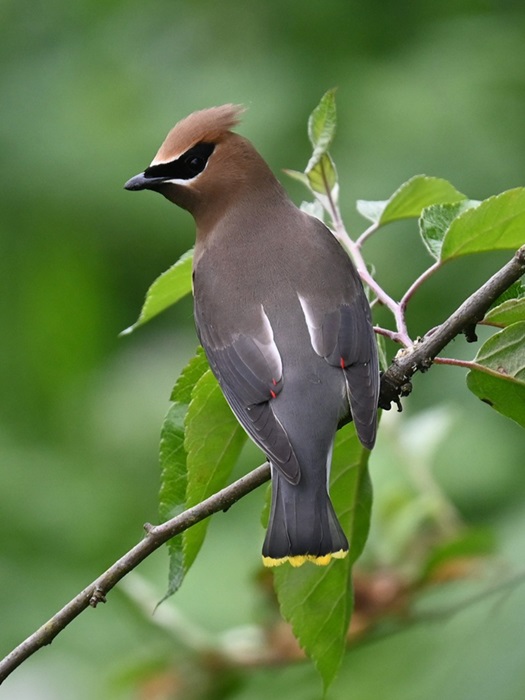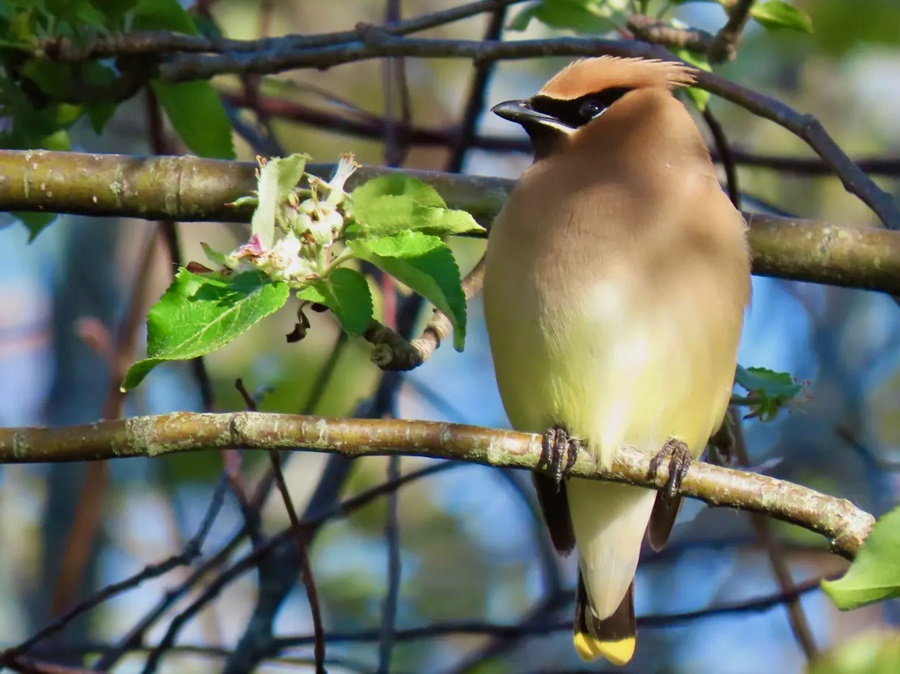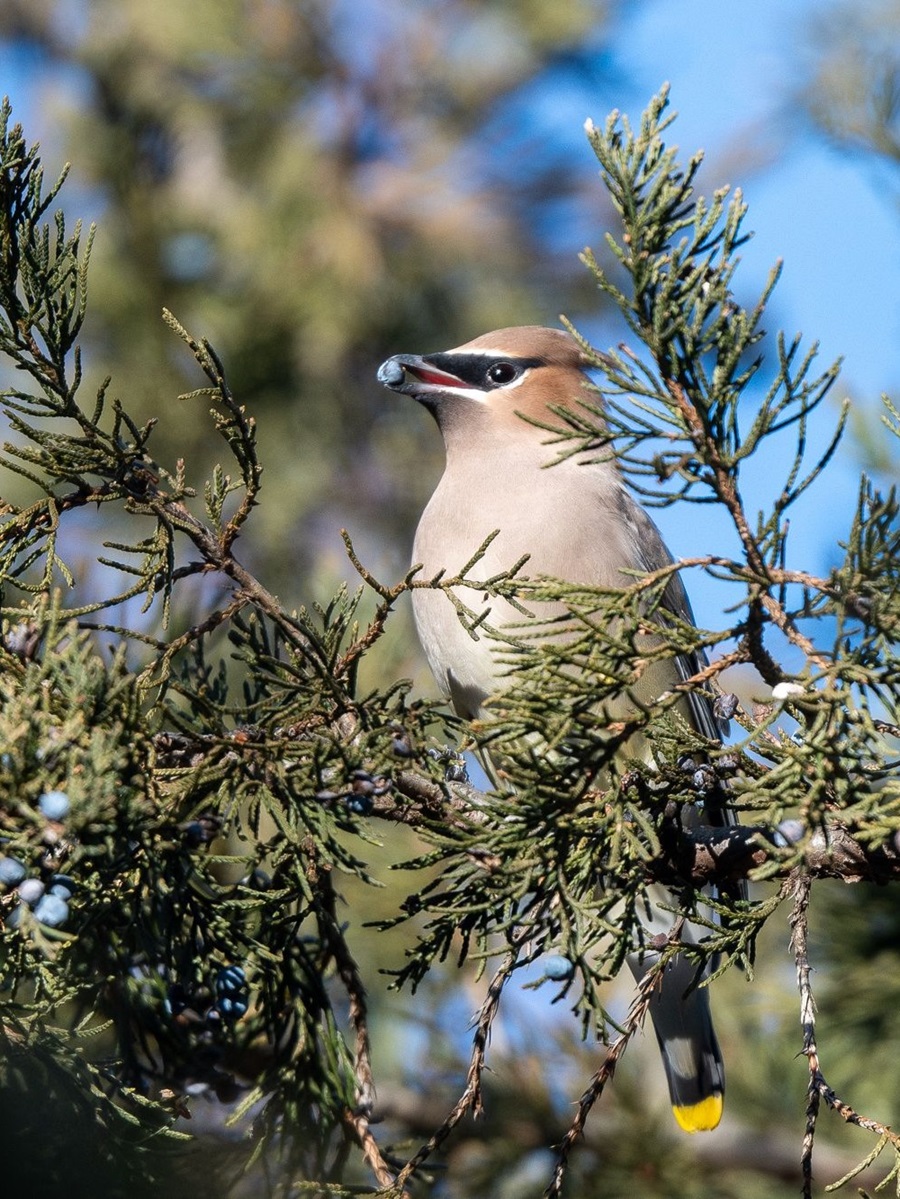It was such a soft note, a faint lisping sound from nearby, I wasn’t sure I’d heard it at first. It called again. I scanned the wet leaves of the flowering apple tree. A movement I thought was a bird was instead a drop of rain bouncing off a dewy leaf. Ah, well. Walk on. No. There it was again, a plaintive lisping, this time longer, like a child swishing his tongue against the back of his teeth. I stopped and scanned again, and the tree came alive. Above me, I now realized, was not one bird but tens of birds happily calling to one another as they clumsily ate the white petals of apple blossom.
The crest stood out. And the black chevron through its eye cut the bird’s purplish brown plumage in a way that had camouflaged it as I scanned the tree. I brought my binoculars up to my eyes and examined one bird’s crested silhouette.

The cedar waxwing (Bombycilla cedrorum) is in fact largely frugivorous — a fruit eater — and was called the cedar bird early on by Europeans who noted its affinity for eating the berries of the cedar tree (Juniperus spp.).
The common name, waxwing, refers to the shiny tips of its tail feathers and secondary wingtips in such bold red and bright yellow that they appear to have been dipped in thick wax. The rest of the birds’ plumage is a nondescript beige blended with violet and pale pink.
Frank Chapman, a pioneer of American ornithology in the early 20th century, wrote that “waxwings possess in an unusual degree two characteristics which are not supposed to be associated — sociability and silence.” As I gazed in wonder at the apple tree, I could feel what he meant. The birds were there, en masse, quietly eating flowers in the rain, and I would never have known had it not been for that faint whisper.

These are the magicians, the silky, silent nomads who can appear and, in another breath, disappear. This is partly because of their diet. Depending largely on trees’ fruits, they will travel or stay put depending on what’s available. They don’t follow the rules. They nest much later than other birds. Some years they migrate, other seasons no. If fruits are in low supply, they eat buds, petals, and seeds.
Cedar waxwings tend to wait till midsummer to begin nesting, pairing off from their flocks. The nest is constructed of grass, twigs, and bark in the fork of a branch, and females commonly lay five eggs. The male delivers food to the female while she incubates for 12 to 14 days, after which the chicks are fed fruit by the couple until they are able to join a group to overwinter with. Habitat loss appears to be the number one threat affecting their populations — but those have been stable for decades, according to the Cornell Lab of Ornithology.
The family Bombacyllidae has only three species: our cedar waxwing; the more northwestern Bohemian waxwing (Bombycilla garrulus); and the third, which we call Japanese waxwing, found only on the island of Japan (Bombycilla japonica). They belong to an order of birds (Bombacylloid oscines) that includes far-flung relict populations — meaning they used to have wider ranges than they do now — that share their affinity for berries and a few oddball habits. Those include the phainopepla found in our southwestern deserts; the palmchat that nests communally in the tops of a palm tree found only on the island of Hispaniola; and the silky flycatchers that, despite their name, eat mostly fruit.

Last week I observed cedar waxwings guzzling unripe fruit from a large serviceberry (Amelanchier canadensis). They seemed to egg each other on: one would watch the other dive and hover for a second while it snatched the fruit from its stem. Then another bird would dart out to do the same. They were described by early American naturalists as “polite,” and in this instance I could see why. Thomas Nuttall, the English ornithologist who worked in North America in the early 1800s, described a line of waxwings passing a worm from one to the next all the way to the end and back along the line to the same bird that initiated the passing so it could finally eat the worm.
They specialize on sugary berries in the rose family, so if you want to attract flocks of these beautiful birds, I suggest planting apples (Malus sp.), cherries (Prunus sp.), hawthorns (Creatugus sp.), serviceberry (Amelanchier sp.), and blackberries and raspberries (Rubus sp.). If you do, you may one day be surprised the way I was as I stood under that apple tree, in the presence of a flock that has been there lisping quietly and, for a while, unnoticed.



